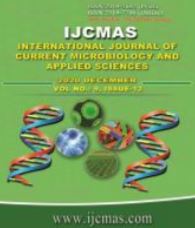


 National Academy of Agricultural Sciences (NAAS)
National Academy of Agricultural Sciences (NAAS)

|
PRINT ISSN : 2319-7692
Online ISSN : 2319-7706 Issues : 12 per year Publisher : Excellent Publishers Email : editorijcmas@gmail.com / submit@ijcmas.com Editor-in-chief: Dr.M.Prakash Index Copernicus ICV 2018: 95.39 NAAS RATING 2020: 5.38 |
Hospital acquired infections (HAI) affect 1 in 10 patients admitted to hospital. They are associated with prolonged hospital stay, mortality and health care costs. If patients survive the initial burn and resuscitative phase, infections are a leading cause of mortality. Also Burn patients are at a higher risk of acquiring HAI with Multidrug resistant (MDR) organisms. Furthermore, infections with MDR pathogens increase morbidity, decrease treatment success, reduce hospital turn-over rate and increase cost of patient care. Samples falling under the inclusion criteria of the study and manifesting any symptoms and signs of hospital acquired burn wound infection during the management of burns were included in the study. HAI were defined based on CDC criteria. Swabs were collected from the wound showing signs of infection and were transported to microbiology laboratory for processing. Positive Isolates were confirmed by conventional biochemical tests. And isolates exhibiting ambiguous taxonomic classification were confirmed by Vitek-2 Compact Automated Identification System. Antimicrobial susceptibility testing was performed using the Kirby-Bauer disk diffusion method according to Clinical and Laboratory Standards Institute (CLSI) guidelines. A total of 71 percent (71/100) of patients developed HAI out of these 71 patients majority (74%) developed burn wound infection .Among the total of 92 pus samples processed 80.43% were positive while as 19.56 % were negative. Out of the total culture positive samples 42.3% showed multiple isolate which mostly comprised of two organisms. While as 19.56 % showed no growth. Dual isolates of P.aeruginosa + Klebsiella spp constituted a majority (50%) of the positives. P.aeruginosa alone was isolated from 16.21% samples followed by Klebsiella (12.16%) and E .coli (5.4%).All the isolates of most frequently isolated organism Pseudomonas aeruginosa were sensitive to polymyxin –b .6.9% were sensitive to imepenem and only 4 % were sensitive to levofloxicin. This isolated Pseudomonas was seen to be resistant to most of the other tested drugs. Out of the 46 Klebsiella isolates all were sensitive to polymyxin –b and to tigecycline, 15(32.6%) were sensitive to minocycine and 2(4.3%) were sensitive to ceftriaxone. HAI with MDR organisms and lack of newer antimicrobial agents with activity against them continues to be a major problem as well as a challenge for microbiologists and clinicians alike .Antibiotic stewardship, tailored infection control policies, regular screening of ICU’S are essential to combat this challenge.
 |
 |
 |
 |
 |